Hair Loss 101
Stages of Androgenic Alopecia
What is causing my hair loss, and what can I do about it? Millions of men and women ask themselves these questions every day. While several conditions can cause thinning hair and baldness, most often it is a result of Androgenic Alopecia, also known as Male Pattern Hair Loss (MPHL), or Female Pattern Hair Loss (FPHL). Androgenic Alopecia is extremely common, affecting 80% of men and 50% of women during their lifetime. It is thought to be caused primarily by genetics and is characterized by loss of hair in specific areas of the head.
Androgenic alopecia has several stages. In men, hair loss often begins at the temples and sometimes the vertex or crown of the head, resulting in a receding hairline and/or a bald patch, eventually progressing to complete baldness. Female pattern hair loss is often more subtle and diffuse, rarely progressing to full baldness. Women may have concentrated areas of thinning at the vertex and the temples. However, the exact pattern and progression of hair loss varies from person to person.
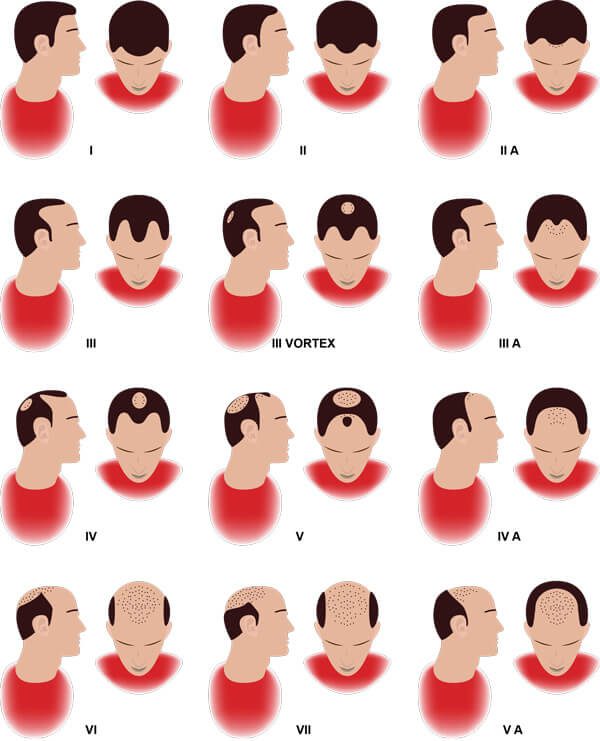
The Hamilton-Norwood scale, showing common patterns and progression of androgenic alopecia in men.
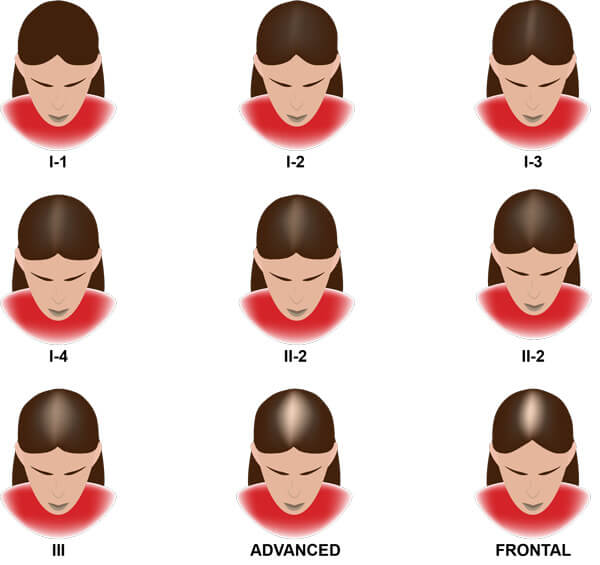
The Ludwig-Savin scale, showing common patterns and progression of androgenic alopecia in women.
So what is actually happening during the different stages of androgenic alopecia? To better understand this, let’s review hair loss 101. Each hair on your head and body arises from a follicle, which is essentially a miniature organ, that is, a collection of cells working together for a single purpose. In the case of a follicle organ, this purpose is to produce hair.
Each follicle will grow its hair in a characteristic cycle with several phases. During the Anagen, or growth phase, the follicle is actively lengthening its hair. This phase can last several years before the follicle transitions to the Telogen, or resting phase, where growth stops, and the hair remains at a constant length and thickness. After several months at rest, the follicle sheds its hair and re-enters the growth phase to begin growing new hair. It should also be noted that the cycles of different follicles are not in sync. That is, at any given time, a different follicle may be either growing, resting, or shedding its hair.
The Hair Cycle
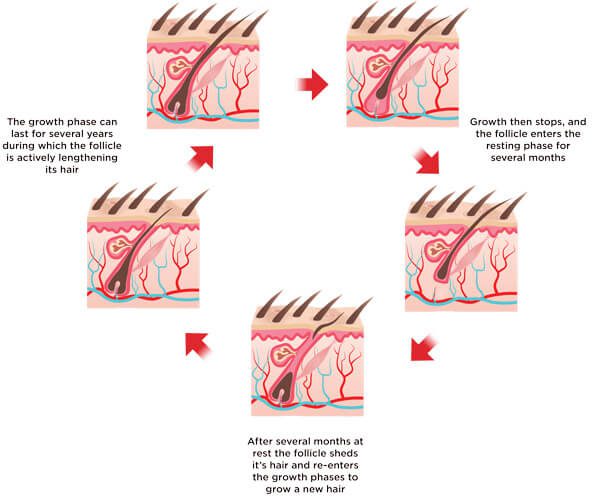
How does androgenic alopecia affect the hair growth cycle? Let’s walk through some more hair loss 101. As the stages of androgenetic alopecia progress, certain hair follicles undergo a process called miniaturization. During miniaturization, the dermal papilla, a specialized group of cells at the base of the follicle, begins to shrink in size, and the phases of the hair cycle undergo changes in their duration. The growth phase shortens, the resting phase lengthens, and the whole cycle shortens in duration, causing hairs to be shed at a faster rate. This process continues, resulting in each cycle of the follicle producing hair that is shorter and thinner than the last.
In more advanced stages of androgenic alopecia, the hair may become so small that it does not even break the skin’s surface. When enough follicles become extensively miniaturized in this way, a person’s hair will become noticeably thin, and bald areas may appear. Miniaturization arises from interactions of the follicle with the hormone dihydrotestosterone, or DHT. Only follicles in certain areas of the scalp are genetically susceptible to the effects of DHT, resulting in the characteristic patterns of thinning and baldness seen in different androgenic alopecia stages.
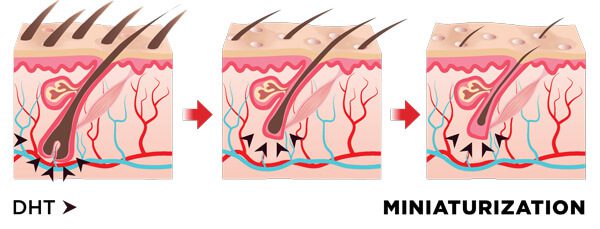
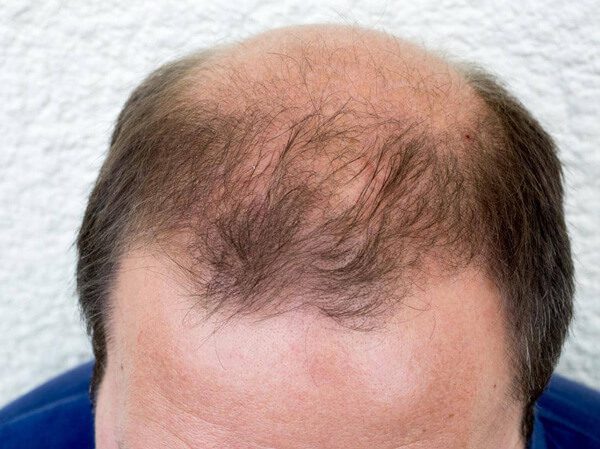
Excessive miniaturization of hair follicles results in areas of thinning and baldness
So How Can I Treat My Hair Loss?
Now that we’ve covered hair loss 101, let’s discuss how to treat androgenic alopecia. Several treatments are available for pattern hair loss. Many that you will find are unfortunately not supported by strong scientific evidence. However, there are some treatment options most medical professionals agree are effective.
- Minoxidil – One of the most established treatments for hair loss, minoxidil is the active ingredient in Rogaine, but can be purchased in many other forms, both over the counter and by prescription. Minoxidil is usually applied topically as a liquid solution, cream, or foam spread onto the scalp. It acts as a potent vasodilator, increasing blood flow to the hair follicles to inhibit miniaturization. Minoxidil is FDA approved to treat pattern hair loss in men and women. However it may not be effective on its own in advanced stages of androgenic alopecia.
- Finasteride – Also known as Propecia, this medication is another established hair loss treatment. Finasteride is a prescription medication normally taken in oral pill form and works by inhibiting the production of DHT. It is proven to be safe and well-tolerated in most patients, although it has shown to cause adverse sexual side effects in a small proportion of men. Finasteride is more effective in the earlier stages of androgenic alopecia. It is FDA-approved to treat male pattern hair loss but is not recommended for use in women.
- Dutasteride – An oral prescription medication that can be used as an alternative to Finasteride, as it also blocks the production of DHT. Similar to Finasteride, Dutasteride has been associated with sexual side effects in a small proportion of men and is not recommended for use in women. Dutasteride is not FDA-approved for hair loss. However, it has been approved for treating pattern hair loss in several other countries and can be prescribed off-label in the United States.
- Spironolactone – A prescription medication used to treat female pattern hair loss. Spironolactone may be taken as an oral pill or applied topically. It works to combat hair loss by inhibiting the production of androgen hormones, including DHT. Spironolactone is not FDA-approved for treating hair loss but can be prescribed off-label. It is not recommended for use in men.
- Hair Transplant Surgery – A surgical procedure that involves moving healthy follicles from the back of the head to thinning and balding areas. Hair transplant surgery is commonly categorized as either traditional Follicular Unit Transplantation (FUT), or Follicular Unit Extraction (FUE), a newer and more minimally invasive procedure. Although hair transplant surgery has gotten a bad rap (think hair plugs), advances in technology and technique have dramatically improved outcomes. Hair transplant surgery can be effective even in more advanced androgenic alopecia stages. If performed properly, patients who are nearly bald can gain a full head of real hair that is permanent and looks 100% natural. However, a transplant can be prohibitively expensive for many people, and results may vary substantially depending on patient genetics, hair loss pattern, and the surgeon’s skill and experience. Hair transplant surgery is best in more advanced stages of androgenic alopecia after other less invasive treatments have been tried and failed.
- Platelet Rich Plasma (PRP) – A new procedure for treating hair loss performed in a doctor’s office. PRP involves taking a small blood sample, processing it to isolate certain cells (platelets), and re-injecting this solution into the patient’s scalp. PRP is minimally invasive, generally painless, takes under an hour to complete, and can be effective for early stages of androgenic alopecia in men and women. Although research on PRP is still ongoing, it is thought to promote hair regrowth via the release of growth factors from the platelet cells. Other similar treatments such as injection of stem cells or stromal vascular fraction may promote hair growth via a similar mechanism.
- Low-Level Laser Therapy (LLLT) – Also known as Low-Level Light Therapy, Photobiomodulation Therapy, cold laser therapy, or laser hair therapy, LLLT is an effective, safe, and versatile treatment for pattern hair loss in both men and women. The gold standard in hair loss treatment, LLLT does not involve drugs or surgery, is not associated with any serious adverse side effects, can be used by both men and women, and can be used in combination with all other hair-loss treatments. Several LLLT devices have been FDA-cleared for treating early to advanced stage androgenic alopecia in men and women, including The Original LaserCap! Check out our About Low-Level Laser Therapy page to learn more.
Want to try LLLT for your hair loss?


